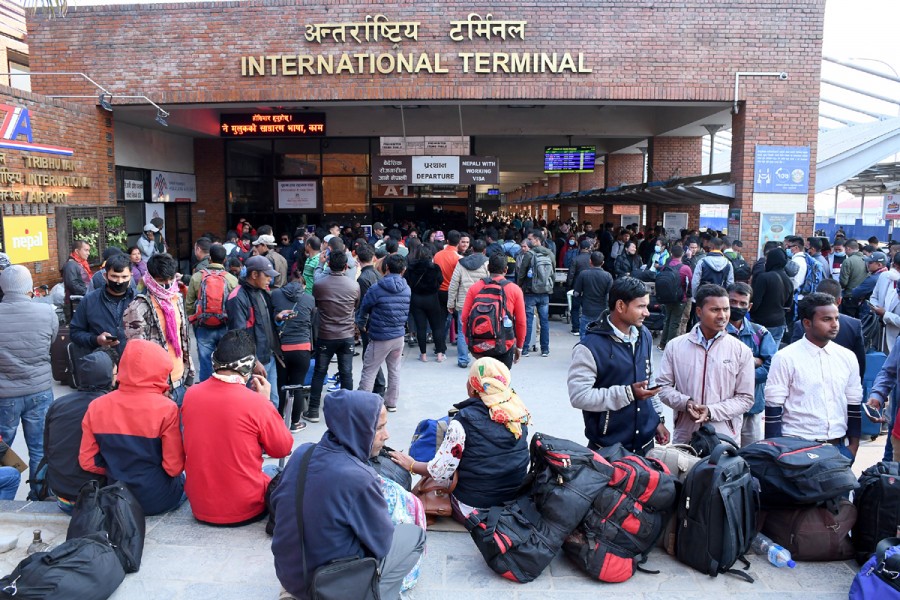Coming back home: The road ahead for migrant returnees in Nepal
IFAD Asset Request Portlet
Publicador de contenidos
Coming back home: The road ahead for migrant returnees in Nepal
Tiempo estimado de lectura: 4 minutosMigrants are essential workers; they contribute to the economy of the places they go and, through remittances, to their communities back home. But with the COVID-19 pandemic, its impact on economies worldwide, and the massive loss of jobs, global remittances to developing countries are expected to fall by US$110 billion in 2020, and not return to pre-pandemic levels for many years. This will affect 200 million migrant workers, half of them women, and their 800 million family members back home.
Nepal is no exception – in fact, as the top recipient of remittances as a share of GDP in South Asia, and the fifth-most remittance-dependent economy (28.6 per cent) in the world after Tonga, the Kyrgyz Republic, Tajikistan and Haiti, it is especially vulnerable. Remittances to Nepal from abroad have tripled in the last decade, from US$2.54 billion to US$8.79 billion. With the pandemic, Nepal Rastra Bank, the country’s central bank, estimates inflows to fall by 14 per cent – a severe blow in a country where more than half the families rely on remittances to cushion against shocks and invest in a better future.
In addition to the loss of income, the pandemic poses another challenge. With 15 to 33 per cent of migrant workers expected to lose their jobs and return to Nepal – around half a million Nepali migrants are waiting for flights back home once travel restrictions are lifted, per the government – it will be imperative to integrate them into the domestic job market. Some Gulf countries, which host over a million Nepali migrant workers, have already called on the Nepalese government to repatriate unemployed and stranded workers.

IFAD’s Rural Enterprises and Remittances Project, Samriddhi, works with migrant families to develop and improve on-farm and off-farm enterprises in rural areas. It also helps young people to enter the labour market by making it easier for them to acquire the right technical and vocational skills, enter into apprenticeships, access finance, and aspire to become entrepreneurs. As a result, it is well placed to support the government manage returning workers.
Through 14 migration resource centres established with local government, Samriddhi also provides a range of services to migrant workers. Before they leave, they can find out more about the jobs available in various countries, get information on required skill sets, learn about the standard compensation offered by employers, and go to a pre-departure orientation. They can also get support in dealing with legal issues, such as cheating and fraud by recruiters as well as insurance and compensation claims, in coordination with the Centre for Migration and International Relations (CMIR), a leading non-profit organisation working with migrants.
However, communities now have new needs in a world dealing with COVID-19. Migrants and their families need support to repatriate safely from destination countries. They also need new employment and income-generation opportunities. To respond to this crisis, Samriddhi, in close coordination with municipalities, undertook a telephone survey. Focussing on migrants who returned in the week of 23 March and onwards, the standard questionnaire complies data on the type of job the job-seeker is interested in, the skills the job-seeker is holding and the willingness to re-migrate to the destination country if the situation returns to normal, and the support they seek in country upon return.
The survey was launched in mid-April 2020 and is currently ongoing. So far, 652 migrant returnees from 67 municipalities across 67 districts have responded, with the following provisional data:
- The Gulf countries are the main desired destination (55 per cent), followed by Malaysia (23 per cent), India (19 per cent) and other countries (3 per cent). Migrants are spread across a total of 18 countries.
- In terms of job types, 46 per cent were employed in an elementary occupation (cleaning and laundry, packaging/loading/shipping/ delivery); 17 per cent in sales and services (baker/dessert maker, barista/coffee maker, beauty & fitness, caregiver/nursing aide, housekeeping, security, tailor, waiter/waitress); 13 per cent in construction (carpenter, mason, painter); 8 per cent in electrical and mechanical roles (A/C technician, automotive, electrician, plumbing, welder); 6 per cent as drivers/machine operators; and 4 per cent each in agriculture and manufacturing.
- Migrant returnees have also acquired other skills either from Nepal or from the destination country. These include almost 50 per cent in agriculture followed by driving, cooking, electric equipment repairing, carpentry and masonry.
- About 77 per cent of the returnees are no longer willing to re-migrate abroad.
- About 60 per cent of the returnees not willing to re-migrate have shown interest in engaging in agriculture for livelihood opportunities in Nepal. Less than 30 per cent are looking for a job with the skills they have or with additional training. Skills training, access to finance, technology and market linkages were the top areas respondents identified to support their enterprise start-ups.
These early results have informed the project’s annual work plan and budget for the next fiscal year, with the programme now including support for migrant returnees to engage in agriculture, which could help create employment, as well as address any emerging food crisis. The project will also organize technical and vocational training for around 25,000 young people, particularly migrant returnees, with local and provincial governments. The survey information will be used to establish a database in each municipality. Samirddhi with the International Organization for Migration, CMIR and the Peoples Forum, will support the local government in designing policy and programmes to reintegrate migrant returnees and ensure access to easy finance for small and micro enterprises and start-ups.
Fecha de publicación: 16 junio 2020